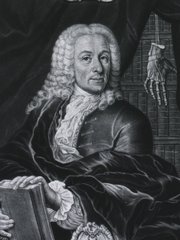|
Lorenz Heister (1683-1758) A German surgeon, physician, anatomist, and botanist, Lorenz Heister [also known as Laurentius Heisterus] was born at Frankfurt-am-Main in 1683. As a result of his early studies, he became proficient in Latin, French, English and Dutch. He started medical studies at the University of Giessen, later continuing in Amsterdam, and Leyden, where he obtained his MD degree in 1708.
For a short time Heister became an army surgeon. In 1710 he was appointed Professor of Anatomy and Surgery at the University of Altfdorf. Although he lectured in Latin, Heister published his anatomical treatise “Compendium Anatomicum” in German in 1718. Later, Latin, French, Italian, and Spanish translations were created and published. Heister’s book became the main anatomical and surgical textbook in Europe. The English version was first published in 1743.
Heister is considered the “Father of German Surgery”, including in his books the management of hemorrhage, wounds, fractures, bandaging, instrumentation, and surgery. Heister described the surgical treatment of breast cancer, hemothoraces, spinal fractures, trepanation, oral surgery, and even obstetrical emergencies. He introduced the term “tracheotomy.” Heister also studied the eye, confirming that cataracts are formed within the lens.
|

Original image courtesy of "Images from the History of Medicine" at www.nih.gov |
| His name is remembered eponymically in two structures:
•. Heister’s valve (plica spiralis) a spiral fold of mucosa found in the cystic duct
•. Heister’s diverticulum (bulbus superius venae jugularis interna), a dilation of the internal jugular vein found at its origin from the jugular foramen of the base of the cranium
Heister's name is spelled Heisters, in his "Compendium Anatomicum" published in 1756.
Sources:
1. "Heister of the spiral valve of Heister - Lorenz Heister" Gastroenter Hepat News (2006): 131 (3) 696.
2. “Lorenz Heister: Surgeon (1683-1758)” Stewart, J. Can Med Assoc J. 1929 20(4): 418–419.
3. "Lorenz Heister (1683-1758). Eighteenth century surgeon" JAMA 202 (11), 1048-1049
4. "Lorenz Heister and oral disease with the original text from his papers". Shklar , G. J Hist Dent (2007); 55:2 68-74
|



